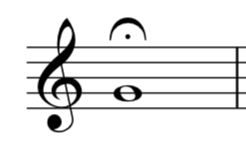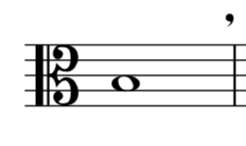I. Fundamentals
Other Aspects of Notation
Chelsey Hamm
Key Takeaways
- Dynamics indicate the loudness of music. Musicians use a variety of Italian words to specify dynamics in Western musical notation.
- A crescendo indicates an increase in loudness, while a decrescendo or diminuendo indicates a decrease in loudness.
- The term articulation refers to the connection or separation between notes, as well as the accent level at the beginning of a note (its attack).
- A tempo indication tells a musician how fast or slow to play or sing a composition.
- Musicians periodize music into historical eras, which are useful to memorize. Works within these historical periods tend to share similar style characteristics.
- Structural features divide up a work or movement into smaller sections.
In this chapter we will explore other elements of music besides pitch (discussed in previous chapters) and duration (discussed in following chapters). These elements include dynamics, articulations, tempi, stylistic periods, and structural markers.
Dynamics
Dynamics indicate the loudness of music. In Western musical notation, we often use italicized Italian words, which can be abbreviated, to describe dynamics. The dynamic marking forte means loud, while piano means quiet. In sheet music, these words are written either above or below the staff.
Several Italian words and suffixes can modify piano and forte to create a range of dynamics from very quiet to very loud (Example 1). The Italian word mezzo means “moderately.” Musicians say mezzo forte to mean moderately loud and mezzo piano to mean moderately quiet. The Italian suffix -issimo means “very” or “extremely.” Musicians say pianissimo to mean “very quiet” and fortissimo to mean “very loud.” This suffix can be stacked; for example, one can say pianississimo to mean “very, very quietly,” or fortississimo to mean “very, very loudly.”

Dynamics are often abbreviated in Western musical notation, as shown below.
- fff = fortississimo
- ff = fortissimo
- f = forte
- mf = mezzo forte
- mp = mezzo piano
- p = piano
- pp = pianissimo
- ppp = pianississimo
Some composers add even more “-issimo“s, but this is rare. However, you might one day spot a pppppp or an ffffff in music that you play or sing!
You can practice ordering dynamics from softest to loudest in the following exercise:
There are three other Italian words that are commonly used to indicate a change in dynamic level. Crescendo (cresc.) means to get louder, while decrescendo (decresc.) and diminuendo (dim.) both mean to get quieter. Crescendos and decrescendos are indicated two different ways: either by writing out the abbreviation cresc. or decresc., possibly followed by dots, or by drawing hairpins. The term “hairpin” refers to the following symbols, which roughly approximate the shape of a bobby pin (or “hairpin”), as seen in Example 2.

Articulations
The term articulation refers to the connection or separation between notes and to the accent level at the beginning of a note (its attack). Like dynamics, articulations in Western musical notation are usually written in Italian. Several articulations are demonstrated in Examples 3–7. Percussion instruments, plucked strings, bowed strings, winds, brass, and voices all have different methods of carrying out particular attacks and articulations. You will want to consult with a private teacher or ensemble director for help with applying different articulations to your instrument or voice.
Example 3: Legato means to play or sing smoothly or connected. This articulation is indicated by a curved slur marking.
Example 4: Another way to indicate smooth, connected playing is with tenuto markings, which look like a small line above or below notes.
Example 5: Staccato means to play or sing notes more separated, leaving space between notes. This articulation is usually indicated by a dot placed above or below notes.
Example 6: An accent (a sideways V) means to play or sing a note with extra stress or emphasis.
Example 7: A marcato marking (an upside-down V) means to play or sing a note with a more forceful accent.
-
Example 3. Slurred notes.
-
Example 4. Tenuto notes.
-
Example 5. Staccato notes.
-
Example 6. Accented notes.
-
Example 7. Marcato notes.
Accented notes can also be indicated by the italicized abbreviations sfz, sf, or fz (sforzando, forzando, or forzato). These accents are usually interpreted to be slightly more forceful (i.e., louder) than regular accents. These symbols work like dynamics and are placed directly above or below the note to which they apply.
Tempo
Tempo (plural tempi) is the term for how fast or slow a composition is performed. Tempi are usually indicated either specifically, by a metronome marking, or less specifically, by a textual indication. A metronome marking is usually indicated in beats per minute (bpm). A work that is marked ♩ = 60 would contain 60 quarter notes in one minute (one quarter note per second). With a free metronome application on your phone, you can easily check the tempo of a work you’re playing or singing.
Like dynamics, most tempo markings are written in Italian. They often appear at the beginning of a work, movement, or section, at the top left of the first staff or system. The most common tempi are as follows:
- Fast tempi: vivace, presto, allegro, allegretto (-etto is an Italian suffix meaning “little”)
- Medium tempi: moderato, andante
- Slow tempi: adagio, largo, lento, grave
Example 8 depicts tempi from the slowest to the fastest:

You can practice ordering tempi from slowest to fastest in the following exercise:
Composers sometimes use additional Italian words, especially emotive expressions, to modify a tempo marking. Words like assai (“very” or “rather”), espressivo (“expressively”), or cantabile (“singingly”) frequently appear after tempo markings, especially in works written after the year 1800. For example, one might come across tempo markings like “allegro assai” (“very fast”), “andante cantabile” (“a moderate tempo, singingly”), or “adagio espressivo” (“slow and expressive”). Always be sure to look up the definition of any words that you do not know in your music.
Two other Italian words are commonly used to indicate changes in tempo: ritardando (rit.) for a gradual decrease and accelerando (accel.) for a gradual increase. Both words are generally italicized, and they are often abbreviated (rit. and accel. respectively). When these directions are meant to apply to several measures, they are often followed by dots. The dots continue as long as the direction is meant to be followed.
After a ritardando or accelerando it is common for a composer to return to the original tempo. In order to do this, they will write a tempo, which is usually placed above the staff. Example 9 shows an excerpt from Ludwig van Beethoven’s Für Elise (1810):
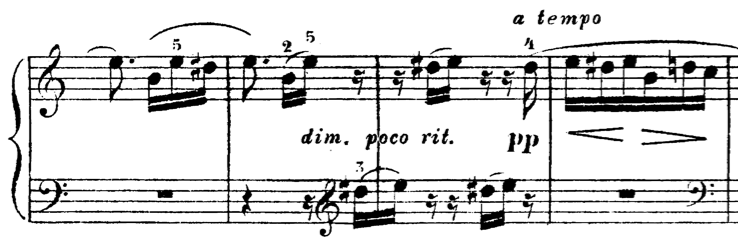
In the third measure of Example 9, you can see there is a ritardando. Above the fourth measure, a tempo is written, indicating a return to the work’s original tempo.
Structural Features
The following words and symbols indicate structural features in compositions. Structural features divide up a work or movement into smaller sections.
- Example 10: A fermata indicates that a note should be held longer than its regular duration. Fermatas often appear at the start or end of a musical section.
- Example 11: A caesura indicates a break or a musical cutoff.
- Example 12: A breath mark indicates a breath for a wind instrumentalist or a vocalist. For percussionists, keyboardists, or string players, it indicates a pause similar in length to a breath.
- Example 10. A note in treble clef with a fermata.
- Example 11. A note in bass clef with a caesura after it.
- Example 12. A note in alto clef with a breath mark after it.
Repeat signs indicate that a section of music should be repeated (Example 13). If the repeated section ends differently each time, that is indicated with first and second endings (Example 14).
Example 13. Four notes in bass clef surrounded by repeat signs.
Example 14. A repeat sign with a first and second ending in treble clef.
Occasionally you may come across music that has more than two endings. Repeated sections with a third or even a fourth ending are common in some styles of music, such as Broadway musicals. These work like a first and second ending: the third ending is performed after the third time the section is repeated, the fourth ending is performed after the fourth time, and so on.
It is also common to see a single measure or two measures of music repeated. A one-measure or two-measure repeat sign indicates that one should repeat either the previous measure or the previous two measures. Example 15 shows a one-measure repeat sign, while Example 16 shows a two-measure repeat sign:


You may also come across several other structural markers, including D.C. al Coda, D.C. al Fine, D.S. al Coda, and D.S. al Fine. These structural markers make use of two signs, which are useful to memorize. Example 17 shows these signs:
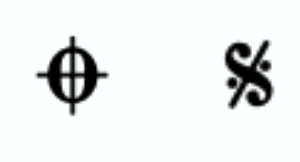
D.C. al Coda, or da capo al coda, means to play or sing a work from the beginning until one sees D.C. al Coda. You then go back to the beginning, and play or sing until the “to coda” sign. You then go to the coda and play or sing until the end of the work. Example 18 shows this process:
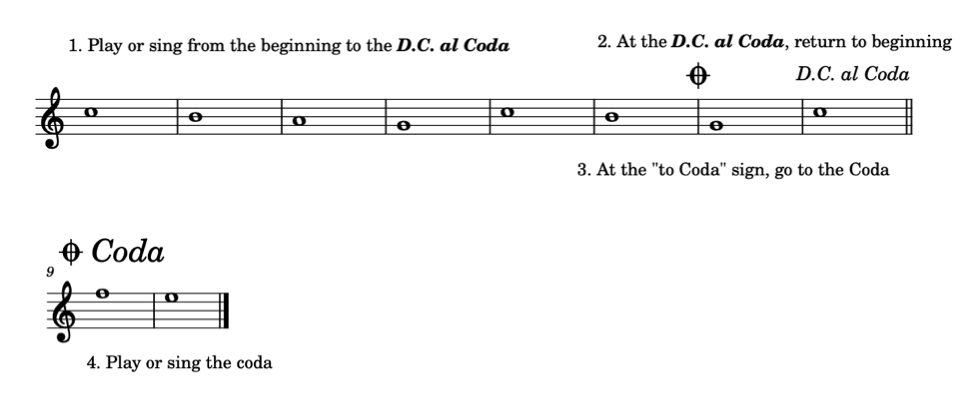
D.S. al Coda works similarly to D.C. al Coda, except that one goes back to the sign on the right of Example 17 instead of the beginning of the work. D.C. al Fine, or da capo al fine, means to play or sing a work from the beginning until one sees D.C. al Fine. You then go back to the beginning, and play or sing until the Fine. Example 19 shows this process:

D.S. al Fine works similarly to D.C. al Fine, except that one goes back to the sign on the right of Example 17 instead of the beginning of the work.
Stylistic Periods
As you begin to study music theory, it will be helpful to have a basic familiarity with the ways in which music theorists and musicologists historically periodize Western classical music. Time periods in the history of this music are flexible, but having a general framework to group musical compositions with certain stylistic similarities can be useful for musicians.
The following time periods, depicted in Example 20, are generally agreed upon by most musicologists:
- Medieval: c. 600–1400
- Renaissance: c. 1400–1600
- Baroque: c. 1600–1750
- Classical: c. 1750–1820
- Romantic: c. 1800–1910
- Post-tonal: c. 1900–present

- Brown, Clive. 2001. “Articulation Marks.” Grove Music Online. https://doi.org/10.1093/gmo/9781561592630.article.40671.
- Gerou, Tom and Linda Lusk. 1996. Essential Dictionary of Music Notation. Los Angeles: Alfred.
- London, Justin. 2001. “Tempo (i).” Grove Music Online. https://doi.org/10.1093/gmo/9781561592630.article.27649.
- McGrain, Mark. 1986. Music Notation. Boston: Berklee Press.
- Roemer, Clinton. 1985. The Art of Music Copying: The Preparation of Music for Performance, 2nd edition. Sherman Oaks: Roerick Music Company.
- Thiemel, Matthias. 2001. “Dynamics.” Grove Music Online. https://doi.org/10.1093/gmo/9781561592630.article.08458.
- Tilmouth, Michael. 2001. “Repeat.” Grove Music Online. https://doi.org/10.1093/gmo/9781561592630.article.23214.
- Westrup, Jack. 2001. “Da capo.” Grove Music Online. https://doi.org/10.1093/gmo/9781561592630.article.07043.
- Tutorial on Dynamics (Music Theory Academy)
- Tutorial on Dynamics (Lumen’s Music Appreciation)
- Articulations (BBC)
- Articulations (libretexts.org)
- Tempo (BBC)
- Tempo (Music Theory Academy)
- Notes on Periodization in Musicology (Oxford History of Western Music)
- Historical Eras in Musicology (Naxos)
- Music Notation Style Guide (Indiana University)
- Dynamics, pp. 13–17 (.pdf), (.pdf, .pdf), and pp. 1–2 (.pdf)
- Articulations (.pdf, .pdf)
- Tempo (.pdf), and pp. 3–4 (.pdf)
- Structural Markers (.pdf, .pdf)
- Mixed Terminology (.pdf)
- Other Aspects of Notation (.pdf, .docx). Asks students to order dynamics, tempi, and historical periods; draw articulations, structural features, and hairpins; and answer informational questions about these aspects of notation.
Media Attributions
- Dynamics Scale © Nathaniel Mitchell is licensed under a CC BY-SA (Attribution ShareAlike) license
- Crescendo and Decrescendo © Chelsey Hamm is licensed under a CC BY-SA (Attribution ShareAlike) license
- Tempi © Nathaniel Mitchell is licensed under a CC BY-SA (Attribution ShareAlike) license
- Für Elise A Tempo is licensed under a Public Domain license
- Single Measure Repeat © Chelsey Hamm is licensed under a CC BY-SA (Attribution ShareAlike) license
- Two Measure Repeat © Chelsey Hamm is licensed under a CC BY-SA (Attribution ShareAlike) license
- To Coda and Segno Sign © Chelsey Hamm is licensed under a CC BY-SA (Attribution ShareAlike) license
- D.C. al Coda © Chelsey Hamm is licensed under a CC BY-SA (Attribution ShareAlike) license
- D.C. al Fine © Chelsey Hamm is licensed under a CC BY-SA (Attribution ShareAlike) license
- Stylistic Periods Timeline © Nathaniel Mitchell is licensed under a CC BY-SA (Attribution ShareAlike) license
The musical term for loudness.
Getting gradually louder; sometimes represented in notated scores with a hairpin symbol.
Getting gradually softer; sometimes represented in notated scores with a hairpin symbol.
Getting gradually softer; decrescendo.
Refers to both a note's length and the accent level of its attack.
The onset of a note (as opposed to the following sustain or decay).
How fast or slow a work is performed; many tempo markings are in Italian or another non-English language.
To divide time into different periods.
Musical features that pertain to section divisions and form.
Loud.
Quiet.
Moderately.
Italian suffix that means "very."
A crescendo or decrescendo symbol.
Performed smoothly or connected.
A curved line placed over notes to indicate that they should be played or sung without separation.
A type of articulation marking used to indicate smooth, connected playing, indicated by small horizontal lines above or below the notes.
Played or sung with more separation, leaving space between notes.
A stress or emphasis on a note.
To play with a more forceful accent or emphasis.
An indication of tempo in beats per minute (BPM).
A gradual decrease in speed (tempo).
A gradual increase in speed (tempo).
Used after tempo alterations, such as ritardando or accelerando. Indicates a return to the original tempo.
A symbol that indicates one should hold a note longer than its written duration. Notation: 𝄐
Indicates a break and/or a cutoff.
Indicates a breath (for wind instrumentalists and vocalists) or a pause (for percussionists and string players).
Symbols (𝄆 and 𝄇) indicating that a section of music is repeated.
Indicates one should repeat either the previous measure, or the previous two measures.
Da capo el Coda means to go back to the beginning of the work, play or sing to the "to Coda" sign, then jump to the coda.
Da capo al fine means to go back to the beginning of the work and play or sing until the Fine.
Dal segno al coda means to go back to the sign, play or sing to the "to coda" sign, then go to the coda.
Dal segno al fine means to go back to the sign and play or sing to the Fine.
Music scholars.





